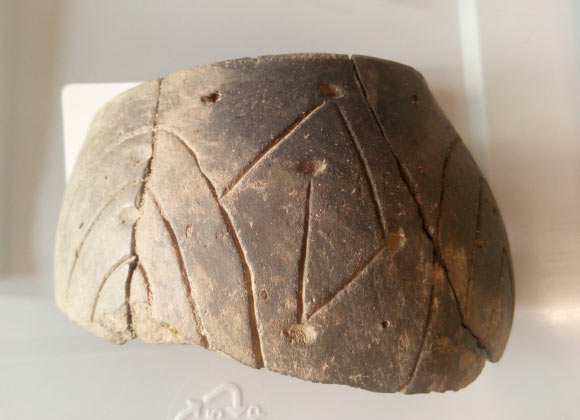Archaeologists have detected traces of dairy fats on the walls of pottery vessels from the settlements of the Linearbandkeramik culture in Central Europe.
Part of a decorative ceramic pot of the Linearbandkeramik culture used for food storage from the Ensisheim site in Alsace, France. Image credit: Emmanuelle Casanova.
The introduction and spread of ruminant animal-based agriculture by early Neolithic farmers had fundamental implications for shaping the Mesolithic-Neolithic transition in Europe, completely transforming prehistoric European culture, biology and economy, in ways that underlie modern life.
Critically, these changes underpinned dissemination of dairy economies globally, and the evolution of lactase persistence in Europeans.
“It is amazing to be able to accurately date the very beginning of milk exploitation by humans in prehistoric times,” said Dr. Emmanuelle Casanova, a researcher at the Muséum National d’Histoire Naturelle in Paris, France.
“The development of agropastoralism transformed prehistoric human diet by introducing new food commodities, such as milk and milk products, which continues to the present day.”
“These settlers of South East, East, and West of Europe were the earliest Neolithic farming groups in Central Europe, known as the Linearbandkeramik culture.”
“The findings showed some of the very first settlers in the region were using milk at scale.”
In their study, which is part of the European NeoMilk project, the authors analyzed more than 4,300 pottery vessels from 70 Linearbandkeramik settlements for their food residues.
The results revealed considerable variation in milk use across the region, with only 65% sites presenting evidence of dairy fats in ceramics vessels, suggesting milk use, while common, was not universally adopted by these early farmers.
Focusing on the sites and ceramics with dairy residues, the researchers produced around 30 new radiocarbon dates to chart the advent of dairy exploitation by Linearbandkeramik farmers.
These new dates correspond to the earliest Linearbandkeramik settlements during the middle of the 6th millenium BCE.
“This research is hugely significant as it provides new insights into the timing of major changes in human food procurement practices, as they evolved across Europe,” said Professor Richard Evershed, a researcher in the School of Chemistry at the University of Bristol.
“It provides clear evidence that dairy foods were in widespread circulation in the Early Neolithic, despite variations in the scale of activity.”
The study appears today in the Proceedings of the National Academy of Sciences.
_____
Emmanuelle Casanova et al. 2022. PNAS, in press;




